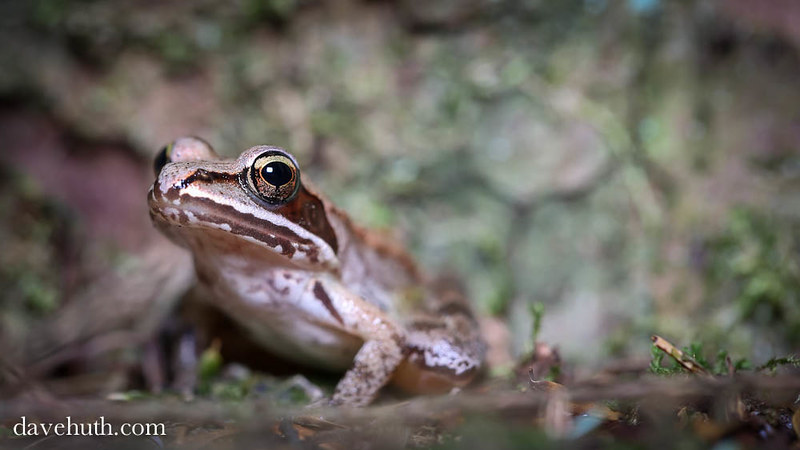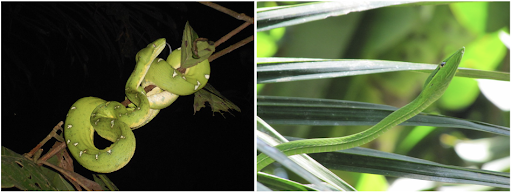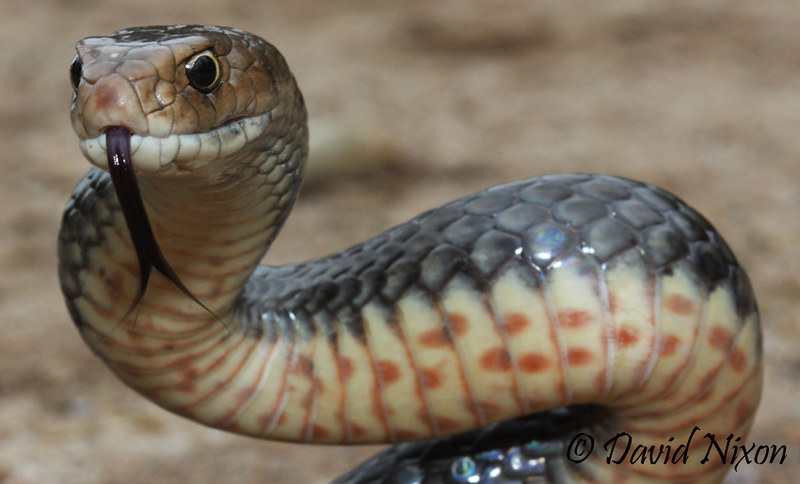Snake Predation Strategies – Part 1: Bodies and behaviours
Last week, in our Sneaky Snake Facts blog, we introduced the link between a snake’s morphology (body form and structure) and its predation strategy. In this series, we are taking a closer look at predation strategies and how morphology is linked to an animal’s environment and behaviour.
Strategies for survival
Living things are adapted to their environment in a way that gives them a better chance of surviving in that environment. For example, an animal that lives in the cold may have thick insulation, such as blubber or fur, to keep it warm. A prey animal, such as a rabbit or deer, may have big ears and excellent hearing to listen out for stalking predators. A predator, such as a fox or tiger, may have sharp curved teeth or claws to help it hold on tight to escaping prey. These features are evolutionary adaptations – traits that help the animal successfully live in its environment. This is at the core of Darwinian evolution, and is popularly known as “survival of the fittest”.
Evolutionary adaptations can occur in all levels of an animal, from the shape of its whole body right down to small specialised molecules within its cells. For example, the wood frog freezes solid during the snowy winters of North America, and when the spring comes it thaws out and hops away unscathed. It survives this process thanks to special protective molecules in its blood and cells.

The wood frog (Rana sylvatica) can survive being literally frozen during winter, thanks to adaptations of the molecules in its cells and blood. Image: Dave Huth/CC2.
These kinds of molecular adaptations are difficult for us to see. However, if you see an animal with a specialised behaviour, chances are it has evolved some very specialised molecules or body parts to enable that behaviour. Sometimes, we can look at an animal’s behaviour in its environment and make a prediction about what unseen adaptations might have evolved. For example, if a frog can survive being literally frozen solid, we can predict that there must be something in its cells that prevents them from being destroyed during freezing.
However, it is often possible to see the products of adaptive evolution when we look closely at the morphology of the animals around us in relation to the environments they are in and how the animals behave in them. We can even find clues in an animal’s morphology that tell us how that animal might live and behave without actually seeing the environment it lives in. Take a look at the pictures below. See if you can guess what kind of habitat these snakes might live in – desert sand, foliage, leaflitter, or water? Their colouration and morphologies give us some very strong clues.

Top left: Gaboon viper (Bitis gabonica), image Michael Jefferies, CC2; top right: White-lipped pit viper (Trimeresurus albolabris), image tontantravel, CC2; bottom left: Desert sidewinder (Crotalus cerastes), image acorbit, CC2; bottom right: Yellow-bellied sea snake (Hydrophis platurus), image The Natural History Museum of Los Angeles County, CC2. What might happen if the Gaboon viper tried to live up in the foliage, or if the white-lipped pit viper tried to live in a sandy desert?
When a good idea’s a good idea
Interactions with other living things and the conditions of an environment influence an organism’s chance of survival and therefore help shape its evolutionary adaptations. Many ecosystems across the world share similar conditions, so it makes sense that some of the adaptations that work well within those environments are also going to be alike. For example, while there are many differences between desert ecosystems around the world, they are all characterised by low rainfall. Therefore, resident animals would benefit from adaptations that help them conserve water. Additionally, sometimes an adaptation might work well in a wide range of environments, such as being able to fly. For these reasons, we sometimes see convergent evolution. This is when two or more different species independently evolve very similar adaptations. This can even make the animals look or behave alike, despite not being very closely related, as in the images below.
 These green snakes are not as closely related as they might look. The snake on the left is a boa that can be found in South America (image Andrew Holmes, CC2), and the snake on the right is a python that can be found in Australia and Papua New Guinea (image Aki Mykkänen, CC2). However, they both live in the treetops of wet tropical rainforests and look and behave very similarly. They even curl up on a branch in the same characteristic way.
These green snakes are not as closely related as they might look. The snake on the left is a boa that can be found in South America (image Andrew Holmes, CC2), and the snake on the right is a python that can be found in Australia and Papua New Guinea (image Aki Mykkänen, CC2). However, they both live in the treetops of wet tropical rainforests and look and behave very similarly. They even curl up on a branch in the same characteristic way.
Sometimes it’s good to specialise
In contrast, we can see in the next set of pictures how different snakes’ morphology can be, even when both are found in the same rainforest, such as the boa (left) and the vine snake (right) of the Amazon. This is partly because they live in a different habitat within the environment, and it is also partly due to their different predation strategies.

The Emerald tree boa (Corallus caninus) (left; image Jo Richmond CC2) lives high up in the canopy of the Amazon, while the green vine snake (Oxybelis fulgidus) (right; image Leonora (Ellie) Enking CC2) lives in the understory vegetation.
Snakes have many morphological features that help them hunt more effectively. You may recall that we mentioned the vomeronasal (or Jacobson’s) organ and its role in helping a snake to “smell” the air with its forked tongue. If the scent is stronger on one tip of the fork compared to the other, the snake knows that the source of the scent is in that direction. There is only a very small distance between each tip of the fork – a few millimetres or so. How much difference do you think there would be in the concentration of airborne chemicals in the space of only a few millimetres? Not much! But snakes can detect these tiny differences, which tells us that their vomeronasal organ is very sensitive.
This adaptation is heavily relied upon by snakes that are active hunters as they search their environment for the scent of something that they recognise as food. Some snakes may target prey that is inactive and hiding, tucked away in a crevice, and so having a fairly thin and agile body can help these species to access tight spaces more easily. Other species that hunt actively may chase down prey, and having a body that is light and strong helps them move more quickly.
 Some snakes rely so heavily on their tongue and vomeronasal organ to find and identify food that it is possible to trick them into eating something they normally wouldn’t. Some researchers even tricked a snake into eating a piece of pasta by coating it with a chemical from frog skin! This is an eastern brown snake that's black in colour. Image David Nixon.
Some snakes rely so heavily on their tongue and vomeronasal organ to find and identify food that it is possible to trick them into eating something they normally wouldn’t. Some researchers even tricked a snake into eating a piece of pasta by coating it with a chemical from frog skin! This is an eastern brown snake that's black in colour. Image David Nixon.
Lying in wait
An ambush hunting snake will use its tongue and vomeronasal organ to detect the scent trails left behind by other animals. This helps it find a good location to sit and wait, such as next to a path that is frequently used by its preferred prey species. Once it has found a good spot, it relies a little less on its vomeronasal organ to encounter prey as it sits and waits for the meal to come to it. Some snakes even have a tail tip that looks a lot like a little worm, which the snake will wriggle in order to attract a hungry animal such as a lizard or mouse. We call this caudal luring (cauda = tail). One species of snake has taken this adaptation to the extreme and has evolved a tail tip that looks like a spider!

The spider-tailed viper (Pseudocerastes urarachnoides) uses its caudal lure to attract birds. Image Omid Mozaffari CC2.
Snakes lying in ambush can keep their bodies very still and they are well camouflaged, so they are very hard to spot. Some species, such as the puff adder in Africa, have even evolved chemical crypsis, which means their own scent is masked so that the animals that might eat them can’t sniff them down easily. This helps the snake to stay in one spot, undetected, for a very long period of time.
Many species of snake that are ambush predators also have heat-sensing pits. These heat-sensitive sensory organs are yet another highly specialised adaptation and are found in pythons, boas, and pit vipers. Often, their targeted prey animals are nocturnal (active at night). These heat-sensing pits enable the snake to “see” the body heat of an animal in the dark, like a thermal imaging camera. Heat-sensing pits are also an example of convergent evolution, as they evolved independently in both the pit vipers and in the boas and pythons.

Heat-sensing pits, such as in this python (top left; image hehaden CC2) or viper (bottom left; image Josh More CC2) help a snake see the heat signals emitted by an animal, like a thermal imaging camera (right; image donnasink CC2)
Snakes that ambush their prey tend to have thick bodies and large heads, and active hunters tend to have long, thin bodies. However, when it comes to the strategies used to actually catch and kill their prey, we find some interesting differences both within and between these groups. This brings us to some of the adaptations that snakes are perhaps most famous for – venom and constriction. Next week, we are going to delve deeper into these predatory adaptations, and we will look at some of the other adaptations associated with being venomous (or not!). So thanks for reading, and stay tuned for next week’s Predation Strategies – Part 2: Catching and killing prey.
- Bianca